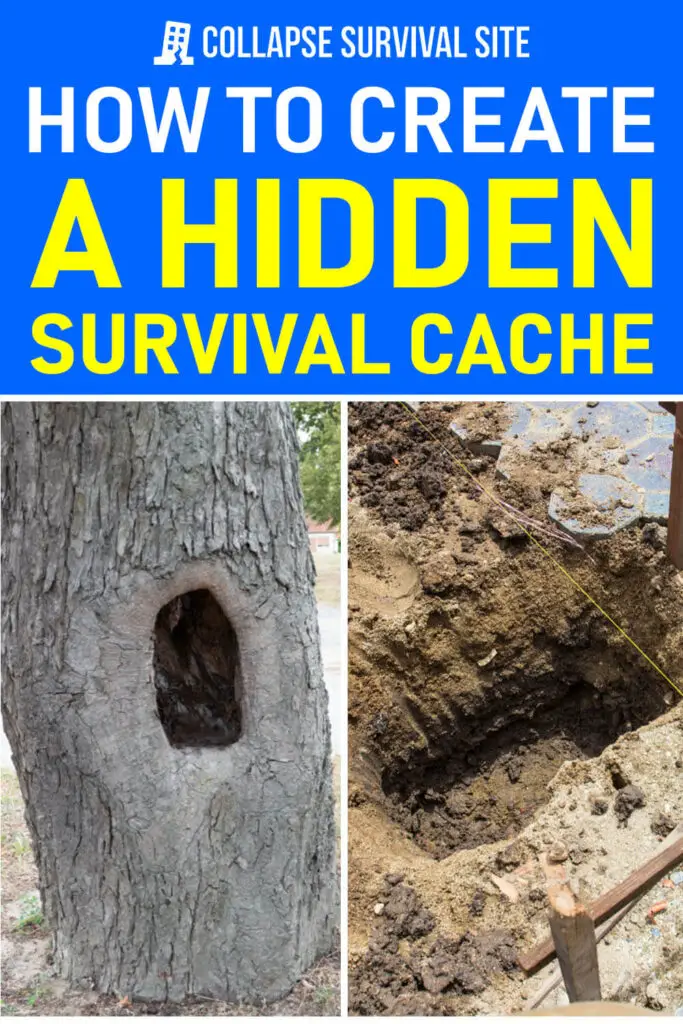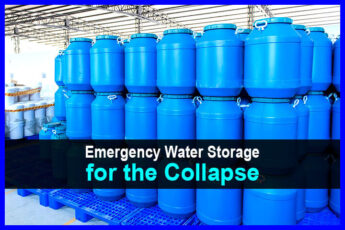Estimated reading time: 9 minutes
Imagine a situation where the grid has gone down and supplies are scarce. Roads are impassable, and help is out of reach. In times like these, having a survival cache could mean the difference between hardship and relative comfort. Hidden away, your cache is a secret trove of essential supplies—a lifeline when all else fails.
In emergency scenarios, survival caches act as crucial fallbacks. This article will guide you through creating one, teaching you what items to include, methods for waterproofing and burial, and strategies for ensuring your stash remains undiscovered until you need it.
Want to save this post for later? Click Here to Pin It On Pinterest!
What are Survival Caches?
Survival caches are strategic reserves of food, tools, medical supplies, and other essential items buried or hidden away for use in times of dire need. The concept is simple: prepare now to thrive later. Just as animals store food for winter, humans create caches, thinking ahead to potential survival scenarios where basic services and supply lines have been disrupted.
The principle behind a survival cache is that during periods of stability, one can plan for the unforeseen, such as natural disasters, major socio-economic upheaval, or widespread emergencies.
A well-prepared cache is not just about hoarding items—it's about careful selection and placement to ensure survival essentials are available and accessible without drawing attention.
It's about the peace of mind knowing that, much like the squirrel with its nuts or the bear with its fat stores, you have a supply put aside that can be drawn upon when the environment turns unforgiving.
How Has the Practice Evolved?
The practice of creating survival caches is not new; it has roots in ancient times. Throughout history, those who successfully anticipated lean times often survived while others did not.
Examples that come to mind include the early hunter-gatherers who buried their provisions, the farmers who stored grain against famine, or war-torn citizens hiding reserves in the rubble of their homes. All of these are historical antecedents of the modern survival cache.
In recent years, the concept has evolved thanks to advancements in materials and technology. Items are now vacuum-sealed, containers are made of durable plastics or metals suited for long-term burial, and locations can be marked with GPS for easy retrieval.
The modern-day prepper movement has also embraced this concept, expanding on the basics to include not just immediate sustenance, but tools for self-defense, power generation, and even temporary shelter.
At its core, a survival cache embodies the principle of anticipating and preparing for the worst. When the storm comes, when the grid fails, or when supplies are cut off, those with survival caches can rest assured knowing they have taken tangible steps to ensure their well-being and that of their loved ones in uncertain times.
Scenarios Where Survival Caches Can Be Lifesaving
Survival caches are not just for extreme adventurers; they can be crucial in a variety of emergencies. Each type of scenario listed below explains why a survival cache would be invaluable.
- Natural Disasters: In the event of earthquakes, hurricanes, or floods, access to basic resources can be abruptly cut off. A survival cache pre-stocked with food, water, and medical supplies can prove to be a lifeline while waiting for rescue or relief efforts.
- Civil Unrest: During times of social upheaval, accessing necessities might become hazardous or impossible. A strategically placed cache can provide you with essential items, allowing you to avoid dangerous areas while remaining self-sufficient.
- Unexpected Wilderness Scenarios: If you find yourself stranded in the wilderness, a survival cache containing navigation tools, shelter materials, and signaling devices can significantly increase your chances of survival and rescue. Those who live nomadic lifestyles will sometimes leave caches in areas that they frequent.
Of course, they aren't limited to just these uses. For example, hunters will leave caches around their properties so they don't have to trek back for supplies during an extended trip. The use case list for these caches is pretty extensive.
Essential Items to Include in Your Survival Cache
When planning a survival cache, it is critical to prioritize essential items that ensure basic needs are met in challenging times. The following list outlines key categories and items to consider when building your cache:
These 4 categories are what should be included in a basic survival cache for civil or natural disasters. It ensures that you have all of the necessities covered without you having to haul it with you in the case of a quick egress.
Food and Water
In the realm of sustenance, your survival cache should include ample long-lasting food items that provide the necessary calories without a high risk of spoilage.
Here are food items that would fare well in a survival cache:
- Dehydrated beef jerky
- Freeze-dried vegetables
- High-calorie energy bars
- Canned beans with a pull-tab opening
- Vacuum-sealed packages of ready-to-eat rice
- Dried fruits like apricots and raisins
- Waterproof packets of powdered drink mix
Access to clean water is one of the most important things to remember. Water purification tablets, portable filters, and iodine solutions are indispensable at a time when all sources are questionable. When researching and purchasing, these items must be compact and have an extended shelf life.
Remember these items when packing your survival cache:
- Portable water filter or straw filter (Lifestraw)
- Water purification tablets
- Ultraviolet (UV) purifier stick
- Lightweight boiling pot for water (titanium is best)
- Chemical disinfectants like chlorine tabs or iodine drops
- Collapsible water containers for storage
- Coffee filters or bandanas for pre-filtering sediments
All of the items listed above don’t take up a lot of space and can provide you with use for up to several months. Don’t skimp on quality. Look for reputable brands and pay a little more if you have to. It could save your life later on down the line.
Shelter and Warmth
Protection against the harshness of the environment is vital, so including emergency blankets or wool blankets that retain heat, as well as compact and robust sleeping bags suitable for various temperatures, is a must. Wool might be a bit bulky or heavy, but it'll keep you warm when it's wet which is a good advantage to have.
Creating a temporary refuge in adverse conditions can help prevent hypothermia and ensure survival in the wilderness. Items that can help achieve this include:
- Compact, lightweight tents: These provide an immediate shelter solution and are easy to transport.
- Emergency bivvies: These are smaller and lighter than tents, making them perfect for emergencies.
- Versatile tarps: They can be used for various purposes such as ground cover or a makeshift shelter.
A useful tip for organization is to wrap up precious fire starting materials to keep them dry. These can include:
- Lighters
- Matches
- Cotton balls / Vaseline
- Ferro rod
- Flint and Steel
- Magnesium firestarters
- Char cloth
Be sure to have at least 2-3 different fire starters in your survival cache. This is just in case one method fails, you’ll have other ones to fall back on.
Tools and Weapons
Your cache should be equipped with versatile multi-tools, which can facilitate a range of necessary tasks, from repairing gear to food preparation. Alongside these, portable saws and hatchets can be critical for woodcutting and shelter building.
Keep a backup knife for redundancy. For defense, consider including non-lethal options such as bear spray and mace, which can provide protection in dangerous wildlife encounters or other threatening situations.
Choosing the Right Container for Your Survival Cache
Selecting the appropriate container for your survival cache is crucial for preserving the integrity and usability of your supplies. Key considerations include:
- Sturdiness
- Waterproofing
- Adaptability of materials
Your survival cache container must offer uncompromising protection against moisture, as water exposure can render crucial supplies like matches, food, and clothing unusable.
Waterproof containers, such as those made from high-impact plastics or metal with watertight seals are what you'll want to keep an eye out for. If moisture gets into that container, then you won't have much of a survival cache.
In terms of durability, materials ranging from polymer plastics to metals like steel ensure the container can withstand harsh conditions, such as being buried underground or exposed to extreme temperatures.
The container's design should also protect against pests and animals. Durability does not necessitate excess weight—an ideal cache container offers a balance between robust protection and portability.
Here are some example of items you can use as survival caches:
- Bear Canisters
- PVC pipe with end caps
- Galvanized steel trash can with locking lid
Lockable lids and corrosion-resistant materials add another level of security and longevity to your cache, ensuring your survival gear remains safe, dry, and intact until needed.
Strategic Locations to Hide Your Survival Cache
Choosing the right places to hide your survival cache can significantly enhance its chance of remaining undiscovered and accessible. Strategic positioning incorporates accessibility, concealment, and protection from the elements to ensure your supplies are ready when you need them the most.
Accessibility
When hiding your survival cache, you must ensure that it's reachable in an emergency without being too obvious to passersby. The location should be familiar and accessible to you year-round, considering changes in weather conditions.
A spot too difficult to reach could render your cache impractical, yet it must be remote enough to avoid accidental discovery by others. Choose a location you can get to safely, quickly, and possibly under adverse conditions.
Concealment
The concealment of your cache is vital in preventing others from stumbling upon it. Natural camouflage, like dense vegetation or rocky overhangs, can be an effective disguise. Alternatively, hiding your cache within plain sight disguised as a common object can also deter attention.
If you have a lot of loose dirt in the area—say a forest with soft, loamy soil—you can dig a hole to lower the cache in. Just be sure the container is waterproofed and that you can dig it out again when needed. Regardless of the method, the cache should blend seamlessly into its surroundings so that it remains undetected and secure until you need it.
Protection from Elements
To maximize the longevity of your survival cache, protect it from weather extremes and environmental factors. Locations that offer natural shelters, like cave systems or sturdy tree crooks, can shield your cache effectively. If you’re going caving, however, be sure to have proper gear and training.
However, when such features aren't available, ensure you provide adequate artificial protection, such as insulation or a secondary waterproof barrier, to maintain the condition of your supplies over time.
Maintenance and Regular Check-ups of Your Survival Cache
Regularly inspecting your survival cache every six months is crucial to ensure its contents remain intact and the cache is free of damage or tampering. During these check-ups, verify the waterproof seals and look for any signs of wear or rust on the container. Replace items that have expired or replenish used supplies.
You'll also want to consider the potential for wildlife interference—the cache should be secure against curious animals that might compromise its integrity. Keeping a log of maintenance schedules can help in tracking the cache’s condition and the durability of its contents, especially for those with forgetful memories.
Final Thoughts
In my opinion, survival caches are an essential component of preparedness strategies and just plain fun to create and leave around your property. They provide peace of mind, knowing resources are available when situations become unpredictable.
Personalized survival caches should reflect your specific situation, needs, and geographic realities. By taking the initiative to create and maintain a well-planned cache, your chances of survival will become much higher in any emergency.
Like this post? Don't Forget to Pin It On Pinterest!









